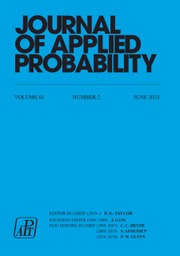No CrossRef data available.
Article contents
Majorization and randomness measures
Published online by Cambridge University Press: 16 October 2024
Abstract
A series of papers by Hickey (1982, 1983, 1984) presents a stochastic ordering based on randomness. This paper extends the results by introducing a novel methodology to derive models that preserve stochastic ordering based on randomness. We achieve this by presenting a new family of pseudometric spaces based on a majorization property. This class of pseudometrics provides a new methodology for deriving the randomness measure of a random variable. Using this, the paper introduces the Gini randomness measure and states its essential properties. We demonstrate that the proposed measure has certain advantages over entropy measures. The measure satisfies the value validity property, provides an adequate extension to continuous random variables, and is often more appropriate (based on sensitivity) than entropy in various scenarios.
MSC classification
- Type
- Original Article
- Information
- Copyright
- © The Author(s), 2024. Published by Cambridge University Press on behalf of Applied Probability Trust



